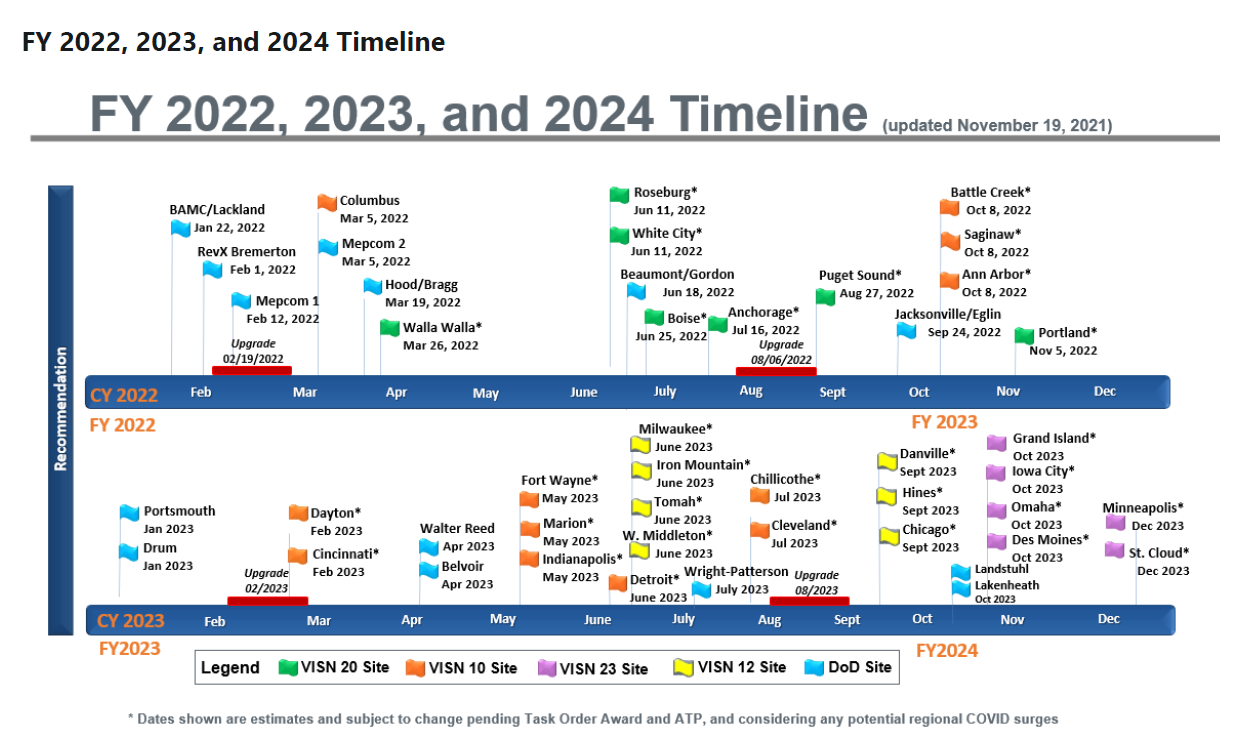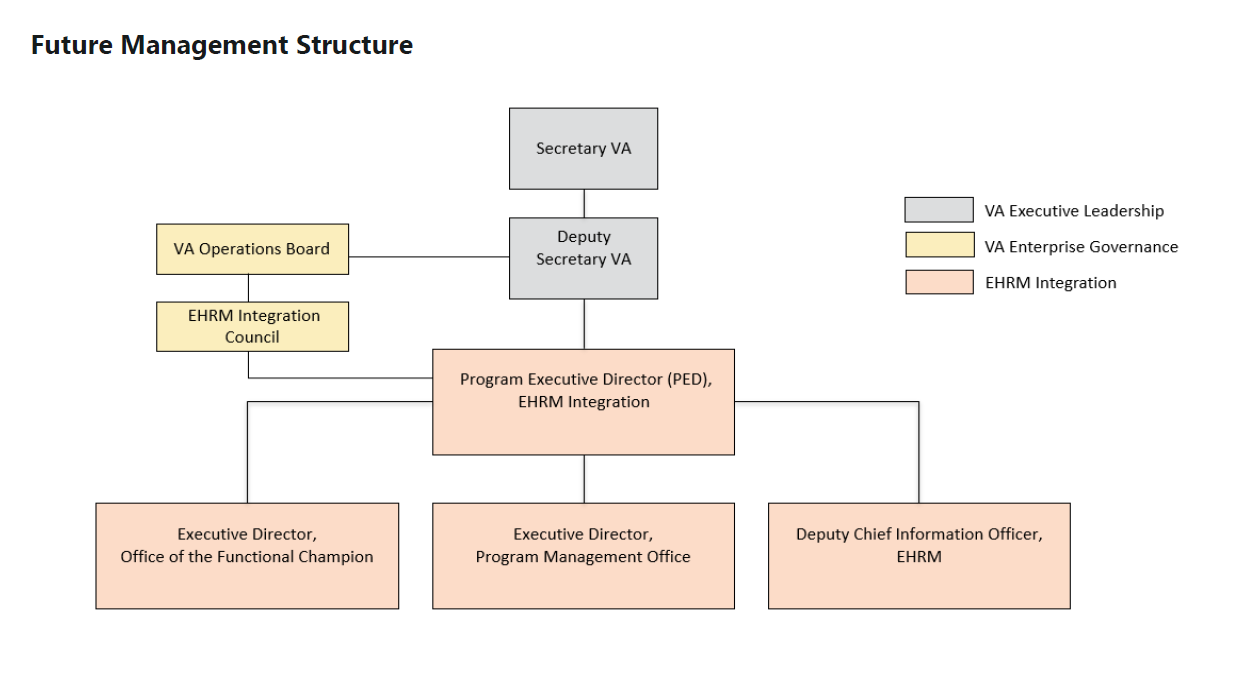

The Department of Veterans Affairs will deploy its electronic health record to a second site in March, with another 10 go-lives tentatively planned for later in...
This story was updated on Wednesday, Dec. 1, 2021 at 5:30 p.m. with additional comments from a Senate Veterans Affairs Committee hearing.
The Department of Veterans Affairs is moving ahead with the deployment of its electronic health record to a second site in 2022, after a strategic review effectively paused the massive, multi-billion dollar project this year.
The review, which VA initiated back in March, uncovered widespread patient safety issues, technical problems, training shortfalls and other budgetary and organizational challenges at the department’s first go-live site.
Now, VA is eyeing March 5, 2022 as the EHR go-live date for its hospital in Columbus, Ohio, with a third go-live tentatively scheduled for the facility in Walla Walla, Washington, about two weeks later.
The department will then move on to five facilities within the Veterans Integrated Services Network (VISN) 20 in the Pacific Northwest next summer. Three more facilities in VISN 10, including the Battle Creek, Saginaw and Ann Arbor hospitals in Michigan, have tentative deployments on the same date in early October.
VA’s final deployment of 2022 may occur next November in Portland, Oregon, according to the department’s schedule.

More than 20 other sites in VISNS 10, 12 and 23 are supposed to deploy the new EHR in 2023, the department said.
That schedule is tentative, VA officials emphasized to reporters during a call Tuesday afternoon, and may change depending on contracting updates and other factors related to the pandemic.
“We will be learning from the upcoming deployments,” a VA official said. “One of the things that we’ve recognized through the lessons we’ve learned from our initial go-live is that there is value — because this will need to be an enterprise solution for all of VA — of having other users from a different medical center who may have different ways that they have traditionally delivered health care coming on board.”
The announcement comes weeks after the House Veterans Affairs Committee said they didn’t see enough progress at VA’s first go-live in Spokane, Washington. More than a year after the initial deployment, members said problems with patient safety, employee morale and productivity persist in Spokane. According to a survey of the Spokane workforce, nearly two-thirds of employees at the facility said they questioned whether they would continue working at VA due to their experience with the EHR rollout.
VA officials on Tuesday said Deputy Secretary Donald Remy recently spent two days with employees and EHR users in Spokane. In a statement, Remy said the new plans incorporated feedback from Spokane employees and Veterans Health Administration leaders.
A department official said VA has made “many, many, many changes” since it first deployed the electronic health record in Spokane last October.
“The low-hanging fruit, where we could configure the record to address an unanticipated issue, those changes have been made,” an official said. “Many of the issues that we are still working on in Spokane are more complicated issues. Often times there [are instances] where staff can support the work flow need, but there is an opportunity to better automate that through technology. Some of those projects and some of that work is going to take some time, because they’re some of the more complicated issues that we’re still working. And again, we believe there’s some value in actually learning from other sites to determine how best to approach this holistically for the enterprise. But the work will continue in Spokane.”
The department on Wednesday released a “progress report” detailing the steps it has taken to try to improve on the challenges it identified this past summer from its strategic review. VA, for example, said it developed a new training environment for employees to test the EHR and finalized a joint data strategy with the Defense Department.
It also worked with Cerner, the lead contractor on the project, to reconfigure and enhance pieces of the EHR and the VA patient portal, the department said.
But the update did little to sway some members of Congress.
“The VA electronic health record modernization effort has become a series of broken promises. Veterans and staff are frustrated, and I am too,” Mike Bost (R-Ill.), ranking member of the House Veterans Affairs Committee, said Wednesday in a statement. “The serious issues with the new system in Spokane are undeniable. Yet VA has been unwilling to face the music and make the fundamental changes that are necessary to fix them. Expanding to Columbus and elsewhere in a few months will only make a bad problem worse for veterans, employees, and taxpayers. I urge Secretary [Denis] McDonough and Deputy Secretary Remy to reconsider.”
At a hearing before the Senate VA Committee on Wednesday afternoon, Patty Murray (D-Wash.) said she appreciated the continued engagement from senior leadership about the EHR.
“But we really do need to see corrective actions to put this important program back on track,” she said.
McDonough said VA is “pressing” on Cerner to step up its presence at the Spokane facility,
“I don’t want to see the new EHR deployed at other sites at Washington state until it’s fixed and ready to go,” Murray added.
VA is also making a variety of organizational and managerial changes to the EHR modernization initiative, which the department said is responsive to the department’s findings from its strategic review and concerns from its inspector general.
The department is creating a new program executive director role for the EHR modernization effort, which will report directly to Remy.
VA has chosen Dr. Terry Adirim, the current principal deputy assistant secretary and acting assistant secretary of defense for health affairs, to serve in that role and oversee the day-to-day EHR operations. Adirim will lead a reworked EHRM Integration Council made up of VA stakeholders from acquisition, data and IT, finance, health and change management experts.

“The whole point of this is to ensure that the majority of the decisions are made through this integration council,” another VA official said.
The department said it’s also strengthening the role of the VHA “functional champion” for the EHR project, which is supposed to ensure clinicians’ concerns and feedback are heard and incorporated into the health record and its associated workflows.
VA is also creating a new deputy chief information officer position, which the department teased during a hearing last month, to focus solely on EHR modernization.
Both the new deputy CIO and the VHA functional champion will report to Adirim.
The original VA Office of Electronic Health Record Modernization, which John Windom previously led, is gone and effectively divided into new organizations, department officials said Tuesday.
“As far as where John Windom leads, the deputy secretary has been very clear with the staff that nobody’s losing their job, and we have other requirements within the department to place people, either to continue to support EHRM or for other areas,” a VA official said.
Copyright © 2025 Federal News Network. All rights reserved. This website is not intended for users located within the European Economic Area.
Nicole Ogrysko is a reporter for Federal News Network focusing on the federal workforce and federal pay and benefits.
Follow @nogryskoWFED


